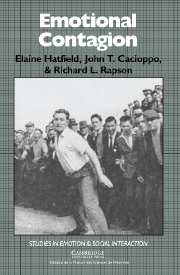Book contents
- Frontmatter
- Contents
- Acknowledgments
- Introduction and overview
- 1 Mechanisms of emotional contagion: I. Emotional mimicry/synchrony
- 2 Mechanisms of emotional contagion: II. Emotional experience and facial, vocal, and postural feedback
- 3 Evidence that emotional contagion exists
- 4 The ability to infect others with emotion
- 5 Susceptibility to emotional contagion
- 6 Current implications and suggestions for future research
- References
- Index
Introduction and overview
Published online by Cambridge University Press: 05 June 2012
- Frontmatter
- Contents
- Acknowledgments
- Introduction and overview
- 1 Mechanisms of emotional contagion: I. Emotional mimicry/synchrony
- 2 Mechanisms of emotional contagion: II. Emotional experience and facial, vocal, and postural feedback
- 3 Evidence that emotional contagion exists
- 4 The ability to infect others with emotion
- 5 Susceptibility to emotional contagion
- 6 Current implications and suggestions for future research
- References
- Index
Summary
Introduction
For over a decade, Richard L. Rapson and I (Elaine Hatfield) have worked together as therapists. Often, as we talk through the sessions over dinner, we are struck by how easy it is to catch the rhythms of our clients' feelings from moment to moment and, in consequence, how profoundly our moods can shift from hour to hour.
One day, for example, Dick complained irritably at the end of a session: “I really felt out on a limb today. I kept hoping you'd come in and say something, but you just left me hanging there. What was going on?” I was startled. He had been brilliant during the hour, and I had not been able to think of a thing to add; in fact, I had felt out of my depth and ill at ease the whole time. As we replayed the session, we realized that both of us had felt on the spot, anxious, and incompetent. The cause of our anxiety soon became clear. We had been so focused on our own responsibilities and feelings that we had missed how anxious our client had been. We had been taken in by her calm, cool cover-up. Later, she admitted that she had been afraid the whole hour that we would ask her about her drug use and discover that she had returned to her abusive, drug-dealing husband.
- Type
- Chapter
- Information
- Emotional Contagion , pp. 1 - 6Publisher: Cambridge University PressPrint publication year: 1993
- 1
- Cited by



